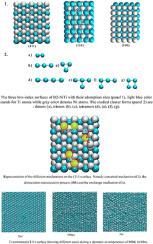当前位置:
X-MOL 学术
›
Surf. Sci.
›
论文详情
Our official English website, www.x-mol.net, welcomes your
feedback! (Note: you will need to create a separate account there.)
Insights into NinTim clusters adsorption and diffusion on B2-NiTi phase from Atomistic Simulations
Surface Science ( IF 2.1 ) Pub Date : 2020-11-01 , DOI: 10.1016/j.susc.2020.121655 L. El Atouani , K. Sbiaai , A. Hasnaoui
Surface Science ( IF 2.1 ) Pub Date : 2020-11-01 , DOI: 10.1016/j.susc.2020.121655 L. El Atouani , K. Sbiaai , A. Hasnaoui

|
Abstract In this work, we aim to study the adsorption and migration of NinTim (n,m=1-4) clusters on low-index B2-NiTi surfaces (100), (110) and (111). Ni and Ti diffusion was investigated using molecular static simulations with the conjunction of the MEAM formalism to describe atomic interactions. Ni-rich clusters are found to be more mobile than Ti-rich ones on Ni- and Ti-terminated (100) surfaces. On the other hand, the activation energy of Ni diffusion on the mixed (110) is found to be 0.51 eV, while that on Ni- and Ti-terminated (111) surfaces corresponds to barriers of 0.61 eV and 0.71 eV, respectively. These results demonstrate that on the (110) surface, a high thermal activity of clusters is expected due to the lower migration barriers. In addition, the diffusion mechanisms of Ti and Ni adatoms are quite similar and are characterized by a hopping mechanism between adsorption sites. While for the small cluster diffusion such as dimers, trimers and tetramers a variety of mechanisms is noted. Using classical molecular dynamics, we found that at 800 K, the Ni-terminated (100) and Ti- terminated (111) surfaces show an important segregation effect of Ni atoms on the surface. We have also found that the homogenous Ti clusters are stable on most surfaces with slight changes of their forms. While Ni clusters are found to show less stability with a higher mobility of their dissociated atoms.
中文翻译:

从原子模拟中洞察 B2-NiTi 相上的 NinTim 簇吸附和扩散
摘要 在这项工作中,我们旨在研究 NinTim (n,m=1-4) 簇在低指数 B2-NiTi 表面 (100)、(110) 和 (111) 上的吸附和迁移。使用分子静态模拟结合 MEAM 形式来描述原子相互作用,研究了 Ni 和 Ti 扩散。发现富镍簇在镍和钛终止的 (100) 表面上比富钛簇更易移动。另一方面,发现混合(110)上 Ni 扩散的活化能为 0.51 eV,而在 Ni 和 Ti 终止(111)表面上的扩散活化能分别对应于 0.61 eV 和 0.71 eV。这些结果表明,在(110)表面上,由于迁移障碍较低,预计团簇的热活动较高。此外,Ti 和 Ni 吸附原子的扩散机制非常相似,并且以吸附位点之间的跳跃机制为特征。而对于小簇扩散,如二聚体、三聚体和四聚体,注意到了多种机制。使用经典分子动力学,我们发现在 800 K 时,Ni 封端的 (100) 和 Ti 封端的 (111) 表面显示出表面上 Ni 原子的重要分离效应。我们还发现,同质的 Ti 团簇在大多数表面上是稳定的,但它们的形式略有变化。虽然发现 Ni 簇表现出较低的稳定性,但其离解原子的迁移率较高。Ni 封端的 (100) 和 Ti 封端的 (111) 表面显示出 Ni 原子在表面上的重要分离效应。我们还发现,同质的 Ti 团簇在大多数表面上是稳定的,但它们的形式略有变化。虽然发现 Ni 簇表现出较低的稳定性,但其解离原子的迁移率较高。Ni 封端的 (100) 和 Ti 封端的 (111) 表面显示出 Ni 原子在表面上的重要分离效应。我们还发现,同质的 Ti 团簇在大多数表面上是稳定的,但它们的形式略有变化。虽然发现 Ni 簇表现出较低的稳定性,但其解离原子的迁移率较高。
更新日期:2020-11-01
中文翻译:

从原子模拟中洞察 B2-NiTi 相上的 NinTim 簇吸附和扩散
摘要 在这项工作中,我们旨在研究 NinTim (n,m=1-4) 簇在低指数 B2-NiTi 表面 (100)、(110) 和 (111) 上的吸附和迁移。使用分子静态模拟结合 MEAM 形式来描述原子相互作用,研究了 Ni 和 Ti 扩散。发现富镍簇在镍和钛终止的 (100) 表面上比富钛簇更易移动。另一方面,发现混合(110)上 Ni 扩散的活化能为 0.51 eV,而在 Ni 和 Ti 终止(111)表面上的扩散活化能分别对应于 0.61 eV 和 0.71 eV。这些结果表明,在(110)表面上,由于迁移障碍较低,预计团簇的热活动较高。此外,Ti 和 Ni 吸附原子的扩散机制非常相似,并且以吸附位点之间的跳跃机制为特征。而对于小簇扩散,如二聚体、三聚体和四聚体,注意到了多种机制。使用经典分子动力学,我们发现在 800 K 时,Ni 封端的 (100) 和 Ti 封端的 (111) 表面显示出表面上 Ni 原子的重要分离效应。我们还发现,同质的 Ti 团簇在大多数表面上是稳定的,但它们的形式略有变化。虽然发现 Ni 簇表现出较低的稳定性,但其离解原子的迁移率较高。Ni 封端的 (100) 和 Ti 封端的 (111) 表面显示出 Ni 原子在表面上的重要分离效应。我们还发现,同质的 Ti 团簇在大多数表面上是稳定的,但它们的形式略有变化。虽然发现 Ni 簇表现出较低的稳定性,但其解离原子的迁移率较高。Ni 封端的 (100) 和 Ti 封端的 (111) 表面显示出 Ni 原子在表面上的重要分离效应。我们还发现,同质的 Ti 团簇在大多数表面上是稳定的,但它们的形式略有变化。虽然发现 Ni 簇表现出较低的稳定性,但其解离原子的迁移率较高。











































 京公网安备 11010802027423号
京公网安备 11010802027423号